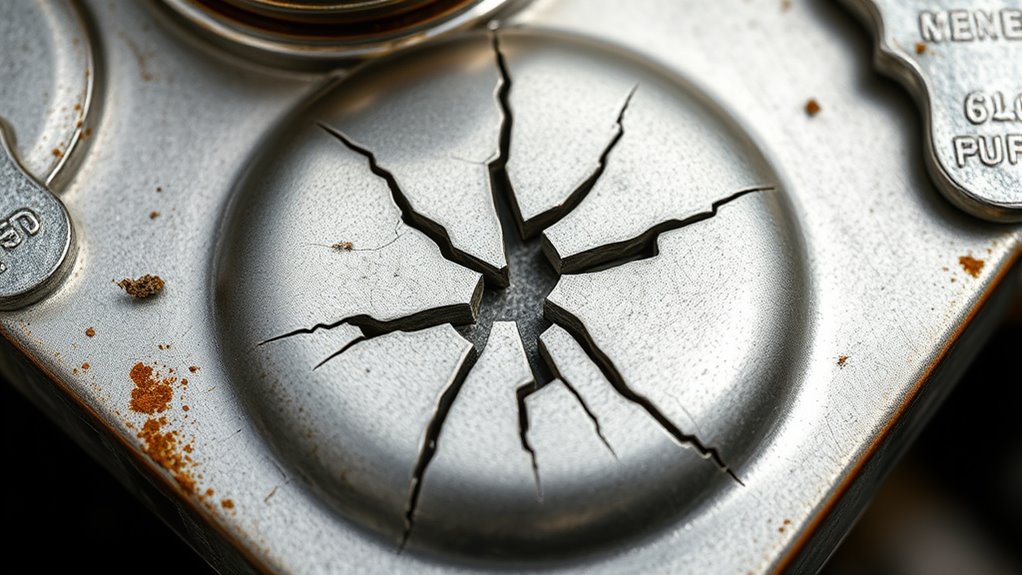Cracks in your suspension mounting points can severely weaken your vehicle’s safety and handling. If you notice unusual noises, vibrations, or handling issues, it’s essential to inspect these areas promptly. Ignoring cracks can lead to suspension failure or steering problems, risking your safety. Repair options include welding for minor cracks or replacing damaged components for extensive damage. To learn more about diagnosing and fixing suspension mounting cracks effectively, keep exploring your options.
Key Takeaways
- Cracks weaken suspension mounting points, risking safety and vehicle handling issues if not addressed promptly.
- Regular inspections help detect early signs of cracks caused by stress, impact, or corrosion.
- Minor cracks may be repairable via welding, but extensive damage often requires component replacement.
- Proper repair includes securing the vehicle, assessing damage, and ensuring suspension alignment afterward.
- Timely maintenance and professional repairs extend suspension component lifespan and ensure vehicle safety.

Suspension mounting point cracks can substantially compromise your vehicle’s safety and handling. When these cracks develop, they weaken the structural integrity of the suspension system, which is essential for maintaining control and comfort during driving. Ignoring these issues might seem minor at first, but over time, they can lead to severe safety risks, including unpredictable steering, uneven tire wear, and even suspension failure. Recognizing the importance of addressing suspension mounting point cracks promptly is indispensable for ensuring your vehicle remains safe to operate.
Cracked suspension mounting points threaten vehicle safety and handling, risking steering issues and suspension failure.
Your vehicle’s safety depends heavily on the integrity of its suspension system. When you notice signs like unusual noises, vibrations, or changes in handling, it’s a clear indicator that something’s wrong with the suspension mounting points. These cracks often originate from stress, impact, or corrosion, and they tend to worsen without intervention. To protect yourself and others on the road, it’s essential to understand the proper repair procedures. Typically, these procedures involve a thorough inspection to assess the extent of the damage, followed by either welding or replacing the cracked mounting components. Welding is suitable for minor cracks, but if the damage is extensive or the mounting points are severely compromised, replacing the entire component is the safest option. Understanding how arcade games work can also help in appreciating the importance of precise repair procedures and reliable hardware.
During repair, safety should be your top priority. This often means lifting the vehicle securely and removing the affected suspension parts with precision. Once the damaged mounting points are exposed, a trained mechanic will evaluate whether welding can restore the structural integrity or if a replacement part is necessary. After repairs or replacements, the suspension system must be realigned to ensure proper handling and tire contact with the road. It’s also wise to verify that all bolts and fasteners are tightened to the manufacturer’s specifications. Proper repair procedures not only restore your vehicle’s safety but also extend the lifespan of the suspension components, saving you money in the long run.
Ignoring suspension mounting point cracks can lead to costly repairs and serious safety hazards. Regular inspections and timely repairs are essential, especially if you notice any symptoms like looseness, noise, or uneven tire wear. When you address these issues early, you prevent further damage and maintain essential vehicle safety. Remember, suspension repairs should always be performed by qualified technicians who understand the intricacies of vehicle safety and repair procedures. Doing so guarantees that your vehicle remains reliable, safe, and comfortable on the road, giving you peace of mind every time you drive.
Frequently Asked Questions
How Can I Prevent Suspension Mounting Point Cracks?
To prevent suspension mounting point cracks, you should regularly perform vehicle maintenance and consider suspension reinforcement if needed. Check for signs of stress or wear and address issues promptly. Properly aligned suspension distributes weight evenly, reducing stress on mounting points. Applying reinforcement materials can strengthen weak areas. By staying vigilant with maintenance and reinforcing vulnerable spots, you can markedly extend the lifespan of your suspension system and avoid costly repairs.
Are Certain Vehicle Models More Prone to These Cracks?
Some vehicle models are like fragile glass, more prone to cracks due to manufacturing flaws or design flaws. You should watch out for signs of susceptibility, especially if your vehicle’s known for weaker suspension mounting points. Regular inspections and maintenance can help catch issues early. Remember, certain models tend to be more vulnerable, so staying vigilant and proactive keeps your ride smoother and safer longer.
What Are the Costs Associated With Repairs?
Repair expenses for suspension mounting point cracks can vary based on the severity and vehicle model. You should expect cost estimates to range from $500 to $1,500, including parts and labor. More extensive repairs or replacements may increase expenses. To avoid surprises, get a detailed estimate from a trusted mechanic and consider preventative maintenance, which can help reduce long-term repair costs.
How Long Does It Take to Fix Suspension Mounting Cracks?
Fixing suspension mounting cracks takes about one to three days, depending on the inspection timeline and repair duration. While the process might seem quick, your mechanic will thoroughly assess the extent of the damage, often requiring extra time for parts or welding. You’ll want to schedule the repair early, so you avoid driving on compromised suspension, ensuring safety and peace of mind. The timeline balances urgency with precision.
Can Driving Habits Influence the Development of These Cracks?
Yes, your driving style and road conditions can influence the development of suspension mounting point cracks. Aggressive driving, like hard turns and sudden stops, puts extra stress on suspension components, increasing crack risk. Rough or uneven road conditions also cause repeated impacts that weaken mounting points over time. By driving more smoothly and avoiding rough terrains when possible, you can reduce stress on your suspension and help prevent cracks from forming.
Conclusion
Just like a ship’s hull weakened by unseen cracks, your suspension mounting points silently compromise your ride’s safety. Ignoring these signs is akin to sailing into stormy seas without a compass. Stay vigilant, inspect regularly, and address any issues promptly. Remember, a sturdy foundation keeps your journey smooth and secure—don’t let hidden cracks steer you off course. Keep your vehicle’s integrity intact, and enjoy the road ahead with confidence and peace of mind.









